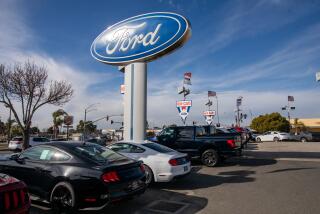Spinning Their Wheels : O.C. Used-Car Firm and Salesmen Take It One Day at a Time in Tough Climate
- Share via
COSTA MESA — Frank Gromak’s gaze was toward his driveway and sidewalk, from where all blessings flow.
Along them come the “ups,” the prospective buyers of Gromak’s used cars. But lately, the ups are down.
“In good times, these cars would be gone in two or three weeks,” Gromak said, gesturing to the 30 or so Toyotas, Nissans, Audis and Oldsmobiles on his small, archetypal used-car lot.
“We sold 30 last month--that’s one a day. That’s not really a good month,” he said. “Nowadays, life is only as good as you can make it.”
Gromak said that despite the recession, they are making it OK at the Costa Mesa Car Co., located for 10 years on Harbor Boulevard near Victoria Street. “For a small lot, 25 or 30 cars a month, that’s pretty good for now,” Gromak said. “You’re not going to make a lot of money, but you’re gonna stay in business.”
And staying in business is a significant achievement, said Daniel Minaesian, the other salesman on the lot that day.
“This business ain’t a picnic. People open up a place and lose their shirts. They think it’s easy. The one on the corner changed twice in three years. On Bay Street, twice in two years. Down from there, at least twice in two years.
“They misjudge the market. They depend on their own taste, but it may not be the stuff that’s selling.”
For the first time since World War II, used cars are outselling new ones--but there’s a catch. New-car sales are way down--10.2% below last year’s subnormal figures. And the increase in used-car sales has been largely in “nearly new” current models such as retired rental cars.
Places such as the Costa Mesa Car Co. are trying to adapt to keep in the black. Trouble is, the used-car business has long ago boiled down to its basics, Gromak said. There’s not much room for adaptations. “You scale your inventory to what’s selling. I don’t know what else you can do.”
So while there may be a Porsche or Mercedes on the lot, “we concentrate on the $2,000-to-$6,000 range--dependable, good used cars. That’s what’s selling nowadays.”
There was plenty of time to talk it over. It was 3 o’clock on a warm afternoon, and no one was on the lot except the people paid to be there.
Gromak and Minaesian were sitting on an old van seat propped like a sofa under the sales office awning. Around them was the merchandise. An orange Porsche beckoned the sporty-minded. A dark Oldsmobile marked Credito Facil suggested “basic transportation.” American flags flew from car antennas, whether Mercury or Mazda.
“Lots of people who need transportation, it’s tougher for them to get financing,” Gromak said. “We have to finance in-house here; we started in July. It does put off the profit for a while. There’s a few lean months until it gets started.
“Most people who can afford something--the ones who have good credit--are holding onto what they have. People who have money aren’t spending it now. People who really need cars, we have to carry them.
“You try to control the risk: as much down as possible and as short as possible--six months, 12 months, 15 months. And you can’t smile until you get all your payments in. We might have that car back on the lot in a month to resell.”
“What about car insurance?” said Minaesian. “That’s a big cost for a $2,000 car. Insurance can be as much as the car payment.”
“You try to keep good-looking merchandise,” Gromak said. “You put up balloons and banners, short of sign pollution. You turn on the car emergency flashers. Yeah, someone pulled in because they saw the flashers. They’d never noticed the lot before. You just try to create traffic.”
Nowadays, the lot stays open and the salesmen stay on duty 12 hours a day. Gromak works seven days a week and has taken on the bookkeeping as well to cut costs.
A woman walked up the driveway and began eyeing a van. Gromak made the approach and after a few minutes was maneuvering her toward a cheaper car. After five minutes, she walked away.
“It was something she couldn’t afford. She has a down payment but no credit. She’s bringing her husband back later to look at a couple of cars.
“I should have got her name and number and called her,” he said, shaking his head. “Most salesmen hate to do it. They’re not used to doing it, because in good times, when someone left, another one would be coming right in.”
“What worked in car sales isn’t gonna work anymore,” Minaesian said. “Dad used to be able to support the family. Now Mom and Dad can’t do it together. New-car dealers started five-year financing. Now people can’t get out from under their old car after three years like they used to.”
A young man walked onto the lot and started leering at the Porsche. Gromak recognized him instantly as a browser. “He went right up to the most expensive car on the lot. But you don’t ignore anybody.”
“Just looking,” the youth said, and Gromak retreated to the sofa.
“These lots get in trouble and they run high-pressure,” Minaesian said. “People don’t respond to that stuff anymore. I’ve been selling cars a lot of years. If you don’t pressure them, they come back.”
“Some people like that--the high pressure and the B.S.,” Gromak said. “You can tell. Some people like the hustle, some people don’t. People buy the salesman, not the product. If they like him, whatever he wants them to buy and points them to, that’s what they buy.”
Fade out, fade in, and it’s nighttime. Sitting on the sofa is a young couple, “a couple of satisfied customers,” Gromak quipped. They chugged in driving a dying ’79 Toyota and Minaesian soon had them interested in an ’83 Chevy Citation. They all headed out for a test drive.
There was no signature yet, but the car was as good as sold, Gromak said. “They bought the sizzle.”
Eh?
“They bought the salesman. They buy the sizzle, not the steak.”
Gromak had agreed to take their Toyota in trade, even though “the brakes are metal-to-metal and the transmission’s trashed.” The lot man was pouring cat litter onto a puddle of crankcase oil where the Toyota had paused to die.
“They drove it until they can’t drive it anymore. That’s what people are doing nowadays,” Gromak said. “We’ll take it, clean it up, fix the tranny, and it’ll be OK for $1,500 or $2,000.”
The sale had lifted spirits and reminded all why they had not quit this business to go into, say, new-car sales. On a used-car lot, there’s a certain tranquillity, Minaesian insisted.
“There’s nothing better than a car lot at night,” he said. “The cars are beautiful, especially when it’s raining. They’re prettiest when they’re wet.
“This is an old piece of Americana. It’s a clean little lot. Andy Griffith should be sitting over there. This is Mayberry. Floyd’s barber shop is right down the street there.
“At a new-car shop, you gotta attack the customer before he gets out of his car or someone else is gonna get him. You get your back broken just trying to get back in your car. In my perspective, this is better. What you get here--I don’t know how to say it. You can wear blue jeans here.
“And people come back for repeat business. But you don’t date customers. Never a date on the first car. I went out with one woman once, but only after the third car.”
The couple drove off in their $1,995, pay-it-off-in-eight-months Citation, and Gromak prepared to shut down.
The books would be easy today: one sale, one solid prospect, one flaky prospect.
“One a day--that’s all I ask for right now,” he said. “That’ll keep us afloat.”
More to Read
Sign up for Essential California
The most important California stories and recommendations in your inbox every morning.
You may occasionally receive promotional content from the Los Angeles Times.













